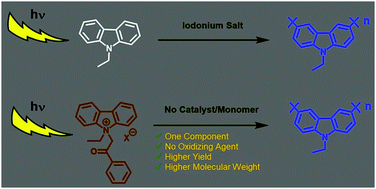Photoinduced synthesis of poly(N-ethylcarbazole) from phenacylium salt without conventional catalyst and/or monomer†
Abstract
We report a new method for the photoinduced synthesis of poly(N-ethylcarbazole) (PEC). Inspired by the photochemical decomposition and electron transfer reactions of N-phenacylethyl carbazolium hexafluorophosphate (ECPhAc) salt, we used ECPhAc as the single molecule possessing both initiator and monomer structures to form PEC with relatively higher yield and higher molecular weight compared to that obtained from the bare monomer. This step-growth approach, eliminating the use of additional oxidizing agent, involves successive photoexcitation, cleavage, electron transfer, proton release, and coupling steps. The structural characteristics, electrochemical properties, and surface morphologies of the obtained PEC before and after the dedoping process were investigated by UV-vis, FT-IR, fluorescence, NMR, MALDI-TOF, SEC, AFM, cyclic voltammetry (CV), and differential pulse voltammetry (DPV). Doped PEC exhibited white light emission covering all visible regions offering a potential application in white light OLEDs.



 Please wait while we load your content...
Please wait while we load your content...